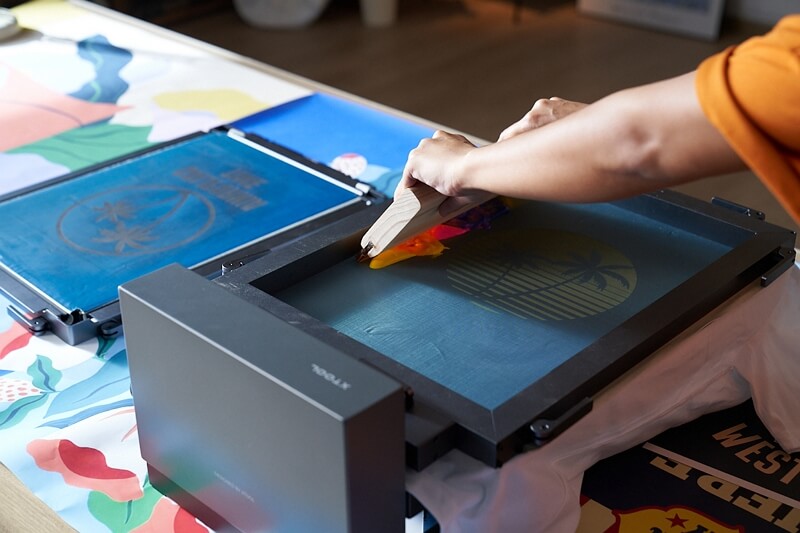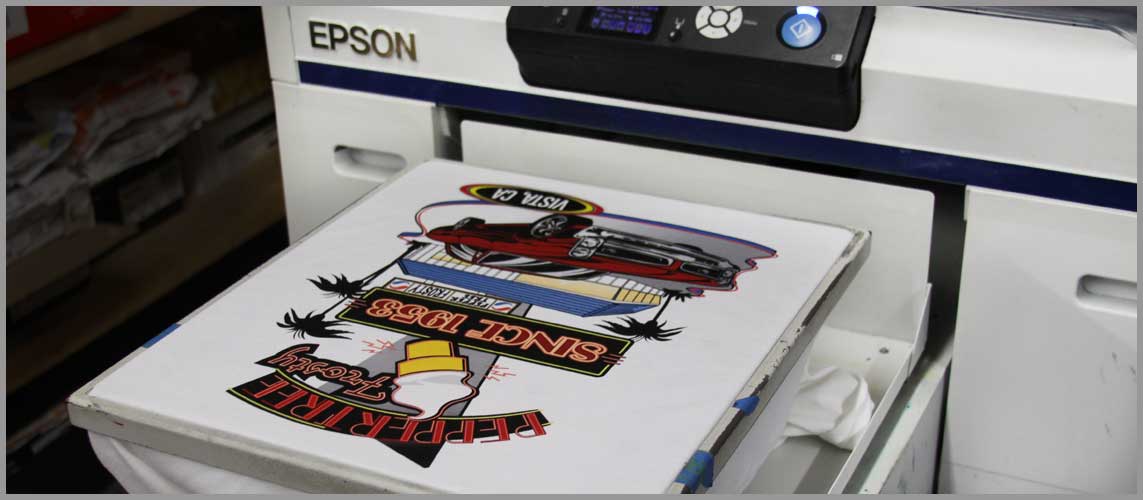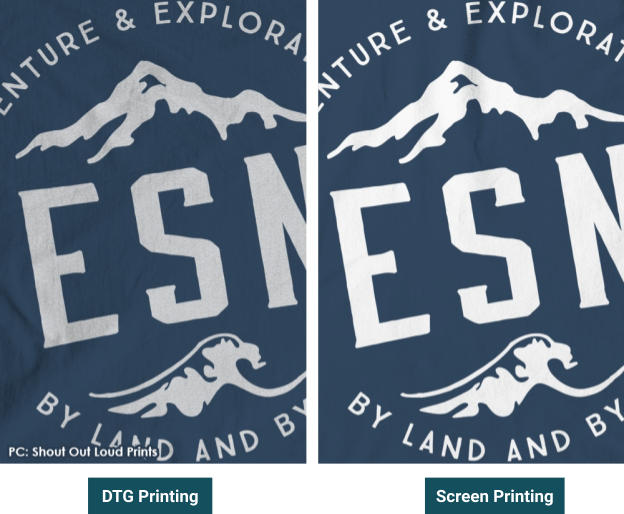Screen Printing Vs Digital Printing (DTG) : Which is Better?
We love to decorate and stylize our clothing to make it uniquely ours, expressing our individual style through the designs we choose. In the market of apparel decoration, there are various methods to imprint these creative designs. Among them, two methods shine in terms of their feasibility and use case: screen printing and digital printing.
But which one is the right fit for your brand? Is it the modern, detailed approach of digital printing, or the classic, vibrant touch of screen printing? It is the right selection that makes all the difference.
In this article, we’ll put both printing methods – screen printing and digital printing – side by side to showcase their differences. We’ll also get into the nitty and gritty of each technique and explain its best use case. Let’s find out which printing process will bring your visions to vibrant life!
In This Article
- Understanding Screen Printing
- Understanding Digital Printing
- Screen Printing Vs Digital Printing: What's the Difference?
- Screen Printing Vs Digital Printing: Which One to Choose?
- FAQs on Screen Print Vs Digital Print
Understanding Screen Printing
Screen printing, also known as silkscreen printing, is a centuries-old technique for decorating and styling materials.
In screen printing, a stencil (made of silkscreen or polyester) is designed based on the artwork you want to print. Once the stencil is ready, it’s placed over the material. Ink is then spread over the stencil, and a squeegee is used to push the ink through the mesh and onto the material. After the ink is applied, it’s left to dry. The final result is a vibrant design on the surface.

The traditional screen printing process can be quite labor-intensive and time-consuming, especially the stencil creation part, which takes days. However, if you follow the innovative screen printing method, introduced by xTool, the process just takes a couple of hours.
xTool offers pre-coated stencils that can be accurately laser engraved. Once the stencil is prepared, the xTool screen printer allows for a very straightforward printing process that involves just three steps. To learn more about this method, check out our detailed guide on how to screen print at home.

Process with xTool Screen Printer

Traditional screen printing process
Pros of Screen Printing
- Prints are long-lasting and withstand multiple washes
- Offers brighter and more vivid colors
- Economical for large quantities due to lower cost per unit
- Suitable for a wide range of fabrics and other materials
- Allow for unique textures and tactile effects on prints
- Ensures uniform quality across all prints in a batch
Cons of Screen Printing
- Not ideal for designs requiring a wide array of colors
- Modifying a design after setup is difficult and costly
- Requires more manual effort than digital printing
- Not the best choice for extremely detailed or photographic images
Understanding Digital Printing
Digital printing is a modern printing method that involves directly transferring a digital image onto a material. Direct-to-garment (DTG) printing is a specific type of digital printing used mainly for apparel, especially t-shirts. The process is similar to how your regular inkjet printer prints on paper. The only difference is that instead of paper, there’s the capability to print on fabrics.

The process begins with your digital design, which can be a photograph, text, or any graphic. This design is processed by a computer and then sent to the digital printer. Unlike traditional printing methods that use stencils, digital printing prints the image directly onto the material. The printer applies tiny droplets of ink, adjusting the color and pattern to match your digital design. As a result, you obtain a print with high levels of detail.
Pros of Digital Printing
- Ideal for intricate designs with a variety of colors
- Minimizes preparation time, perfect for urgent projects
- Perfect for personalized designs
- Typically uses less ink, reducing wastage
- Maintains the natural feel of delicate materials
- Delivers uniform quality across all prints, even in complex designs
Cons of Digital Printing
- Digital prints may fade quicker than screen prints with frequent washing
- Less effective on dark or thick fabrics compared to screen printing
- Less cost-effective for large quantities
- Print size and placement can be restricted by printer limitations
Screen Printing Vs Digital Printing: What's the Difference?
After exploring each printing technique, let’s put screen printing and digital printing head-to-head for a more detailed comparison.
| Screen Printing | Digital Printing (DTG) | |
|---|---|---|
| Materials Supported | Most fabrics, wood, metal, and plastic | Cotton and Polyester |
| Design Complexity | Simple bold designs | Colorful detailed designs |
| Texture | Noticeable texture | Soft feel |
| Color Range | Limited by screens | Unlimited |
| Inks | Plastisol inks and water-based inks | Water-based inks |
| Vibrancy | High | Low |
| Special Effects | Yes | No |
| Cost (Entry Level Setup) | ~$1,500 | ~$3,000 |
| Durability | Long-lasting | Fades over time |
Vibrancy
Vibrant designs are eye-catching, a key goal in apparel design. On comparing two similar designs, one from screen printing and the other from digital printing, we see a noticeable difference in their vibrancy.

Screen-printed designs appear more vivid, particularly on dark fabrics. This is due to the use of plastisol inks in screen printing, which are thicker, more viscous, and opaque, creating a pronounced base on the garment.
On the other hand, digital printers commonly use water-based inks. Although these inks are also vibrant, their semi-transparency on darker backgrounds makes them look dull.
Color Range
Screen printing, while capable of producing vibrant, high-opacity colors, is limited by the number of screens required for each color. This makes it best suited for bold, solid colors and simple designs.
Digital printing, on the other hand, offers a virtually unlimited color palette. It can reproduce full-color images, gradients, and intricate details with precision. However, while digital printing can achieve a wide range of colors, it may not always reach the same level of opacity as screen printing for certain colors.
Design Complexity And Detail
DTG outshines screen printing in detail and design complexity. Since it prints using tiny dots, the design remains fully close to its digital form, with all small details, curves, and edges intact. Additionally, it blends colors in a single pass.
Whereas, screen printing is better for simpler designs with fewer colors. In case, you are using advanced techniques, like laser engraved stencils, complex designs can be handled as well.
Material Versatility
Versatility in printing means being able to print on a range of fabrics. DTG works well on multiple materials but is particularly effective on cotton. It is less suitable for blended or moisture-wicking fabrics. In contrast, screen printing is versatile across different fabric types, including cotton, polyester, blends, and synthetic materials.
For printing on small or irregular items like caps, screen printing offers more flexibility due to its adjustable platens, whereas DTG is better suited for flat items like shirts or hoodies that fit easily on the machine's platens.
Special Effects
For inks that shine, sparkle, or glow, screen printing is the better choice. It supports a wide range of special effects inks. Some DTG machines can use a few special inks, but they don’t offer as many options as screen printing.
Texture and Feel
If you prefer super lightweight shirts with designs that blend seamlessly into the fabric, digital printing is the ideal choice. The ink from digital printers is sprayed on, merging neatly with the shirt and creating almost no extra texture. Since this ink is slightly semi-transparent, it allows air to pass through. This enhances the comfort of t-shirts, especially in warmer weather.
On the other hand, screen printing can sometimes make shirts feel heavier and stiffer. You might notice an extra layer when you run your hand over the shirt. This effect can be reduced with certain additives, depending on your preference.
The comfort is somewhat subjective; it depends on whether you prefer the softer feel of DTG prints or the more pronounced texture of screen prints.
Quality and Durability
DTG prints may start to fade after a dozen washes due to the water-based inks and their less adhesive nature. In contrast, screen-printed designs with plastisol ink can last for years without deteriorating, as long as they are cured properly.
Set up Time and Cost
Traditional screen printing requires considerable time for setup and preparation. Even with premade stencils, applying ink to each piece is time-consuming. In contrast, digital printing is faster as it requires no prior preparation. The printing process itself is also quicker.
However, the cost of digital printing machines is generally higher than that of screen printers. For modern screen printing methods, an xTool screen printer and laser engraver can cost under $1500, while the average price for digital printing machines hovers around $3000. Industrial ones cost even higher.
Speed and Efficiency
Preparing stencils for traditional screen printing can take a couple of days. Even with a premade stencil, it’s still a time-intensive process. On the other hand, printing a shirt with a digital printer is as quick as printing a document on an inkjet printer.
But when considering long-term efficiency, especially for batch production of similar shirts, screen printing is more efficient once the stencil is created. Although the initial setup takes time, the actual production of large quantities becomes much quicker and more efficient compared to DTG.
Screen Printing Vs Digital Printing: Which One to Choose?
After understanding the differences, it’s clear that both methods have unique strengths. Here’s a simple split of the best use cases of each method:
Choose screen printing if you:
- Need bold vibrant prints for logos or text-based designs.
- Plan to print on different fabrics like cotton, polyester, or blends.
- Run a printing business that requires a large batch of shirts.
- Need glitter effects and raised designs.
Go for digital printing (DTG) if you need:
- Need detailed, or full-color designs, like gradients or photos.
- Primarily printing on cotton or light-colored fabrics.
- Have a print-on-demand business or work with small batches.
FAQs on Screen Print Vs Digital Print
Does DTG or Screen Printing Last Longer?
Screen printing uses plastisol sinks, which are known to last for years. Whereas, in digital printing, we have water-based inks, which start fading after a few washes.
Is Screen Printing More Expensive Than Digital Printing?
No, screen printing is quite cost-effective in the long run, especially for batch production of similar design products. The setup cost is also less, if you choose modern tools like xTool screen printer.
What is Digital Printing Best for?
Digital printing is best at producing detailed, multi-colored designs. It is ideal for producing personalized designs and small-scale production.
What are the Disadvantages of Digital Printing?
Digital designs fade over time. The designs don’t stand out well on darker fabrics plus you may struggle with color matchmaking. It’s less cost-effective for large production.


